
The federative units of Brazil are subnational entities with a certain degree of autonomy and endowed with their own government and constitution, which together form the Federative Republic of Brazil. There are 26 states and one federal district. The states are generally based on historical, conventional borders which have developed over time. The states are divided into municipalities, while the Federal District assumes the competences of both a state and a municipality.

Mato Grosso is one of the states of Brazil, the third largest by area, located in the Central-West region. The state has 1.66% of the Brazilian population and is responsible for 1.9% of the Brazilian GDP.

The national flag of Brazil, is a blue disc depicting a starry sky spanned by a curved band inscribed with the national motto "Ordem e Progresso", within a yellow rhombus, on a green field. It was officially adopted on 19 November 1889 — four days after the Proclamation of the Republic, to replace the flag of the Empire of Brazil. The concept was the work of Raimundo Teixeira Mendes, with the collaboration of Miguel Lemos, Manuel Pereira Reis and Décio Villares.

The coat of arms of Brazil was created on 19 November 1889, four days after Brazil became a republic. It consists of the central emblem surrounded by coffee and tobacco branches, which were important crops in Brazil at that time. In the round shield in the center, the Southern Cross can be seen. The ring of 27 stars around it represents Brazil's 26 states and the Federal District.

Cuiabá is the capital city of the Brazilian state of Mato Grosso. It is located near the geographical centre of South America. Also, it forms the metropolitan area of Mato Grosso, along with the neighbouring town of Várzea Grande. The city's name is an indigenous Bororo word meaning 'arrow-fishing', The city was founded in 1719, during the gold rush, and it has been the state capital since 1818. The city is a trading centre for an extensive cattle-raising and agricultural area. The capital is among the fastest-growing cities in Brazil, followed by the growth of agribusiness in Mato Grosso, despite the recession that is affecting Brazilian industries. Cuiabá was one of the host cities for the 2014 FIFA World Cup.
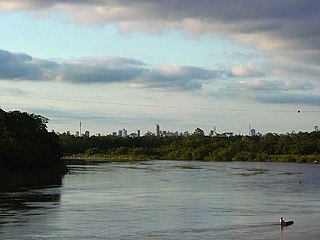
The Cuiabá River is a Brazilian river in the western state of Mato Grosso that flows in the Río de la Plata Basin. It is a tributary of the São Lourenço River.
In Brazil, the Military Firefighters Corps are military public security forces, responsible for civil defense, firefighting and search and rescue inside the federative units. Since 1915, it has been a military reserve force and an auxiliary force of the Brazilian Army, also composing the Single System of Public Security. Members of the Military Firefighters Corps, such as the members of the Military Police, are designated as being part of the military of the Federative Units by the Federal Constitution.

Cuiabá Esporte Clube, commonly referred to as Cuiabá, is a Brazilian professional club based in Cuiabá, Mato Grosso founded on 12 December 2001. It competes in the Campeonato Brasileiro Série A, the top flight of Brazilian football, as well as in the Campeonato Mato-Grossense, the top flight of the Mato Grosso state football league.
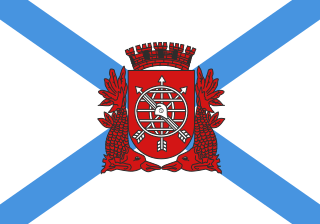
The flag of the City of Rio de Janeiro or flag of São Sebastião do Rio de Janeiro consists of a white rectangle with a blue saltire behind the coat of arms of the city of Rio de Janeiro, which is displayed red in the center. Its basic design has changed little since it was adopted on July 8, 1908, except during period from 1960 to 1975 when the municipality of Rio de Janeiro was known as Guanabara State. It resembles the flags of Galicia and the Russian Navy.
Águas do Cuiabá Ecological Station, formerly the Águas do Cuiabá State Park, is an ecological station in the state of Mato Grosso, Brazil, a fully protected conservation unit in the cerrado biome. There was controversy about the acquisition of land to expand the unit's area when it was made an ecological station.
The Rio da Casca Ecological Station is an ecological station in the state of Mato Grosso, Brazil. It protects a partly deforested area of savanna.

The flag of the state of São Paulo, Brazil, serves as one of the state's symbols, along with the state's coat of arms and anthem. It was designed by the philologist and writer Júlio Ribeiro in 1888, with his brother-in-law, Amador Amaral, a graphic artist. The flag has thirteen black and white stripes and a red rectangle in the upper left corner holding a white circle enclosing an outline map of Brazil in blue. There is a yellow star in each corner of the red rectangle.

Miss Mato Grosso is a Brazilian Beauty pageant which selects the representative for the State of Mato Grosso at the Miss Brazil contest. The pageant was created in 1955 and has been held every year since with the exception of 1990-1991, and 1993. The pageant is held annually with representation of several municipalities. Since 2023, the State directors of Miss Mato Grosso are, Muryllo Lorensoni and Nadeska Calmon.
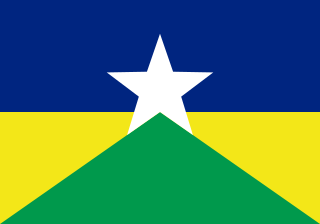
The flag of Rondônia is the official flag of the Brazilian state of Rondônia. The current flag was introduced by the 7th Decree of the state of Rondônia on 31 December 1981, a mere 9 days after Rondônia was elevated from a federal territory to a state.

The state flag of Mato Grosso do Sul was designed by a group of University of São Paulo students and adopted on 1 January 1979 by the 1st decree of the state of Mato Grosso do Sul.

The SESC Arsenal, originally known as the Real Trem de Guerra and later the War Arsenal, is a former arsenal in Cuiabá, Mato Grosso, Brazil. John VI of Portugal mandated the creation of the arsenal in Cuiabá in 1818, shortly before the Independence of Brazil in 1822. It was completed and subsequently expanded in the 1840s in response to territorial disputes with the newly independent Spanish states.
The following is a timeline of the history of the city of Cuiabá, Mato Grosso, Brazil.
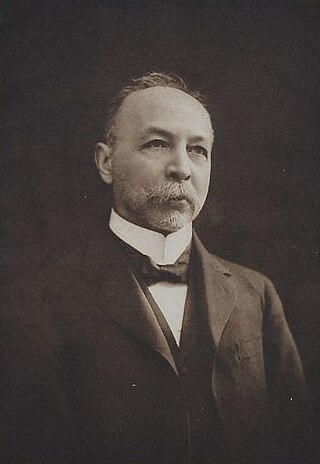
Joaquim Murtinho was a Brazilian physician and politician. Murtinho was born in Cuiabá, the capital of Mato Grosso, and moved to Rio de Janeiro for his education. He graduated from the Faculty of Medicine of Rio de Janeiro and became a physician and later a politician. Murtinho initially served as Minister of Industry, and Commerce (1899–1902) under president Prudente de Morais; then pursued austerity measures as Minister of Finance (1898–1902) under president Campos Sales. Murtinho also served two non-consecutive terms as senator for Mato Grosso, 1890–1896 and 1903–1911.
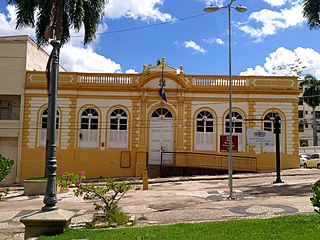
The Former State Treasury Building of Mato Grosso is a historic building in Cuiabá, Mato Grosso, Brazil. It sits on the Praça da República, a public square that was once the center of Portuguese colonial power. It was built in 1896 to house first the state treasury, and later numerous state government agencies. It was ultimately adapted in to the Mato Grosso Historical Museum in 2006, also managed by a state agency. The Treasury Building is one several Neoclassical buildings in Cuiabá. It sits in close proximity to the Palace of Instruction, built shortly afterwards in 1913, in a larger, more eclectic example of the style. The State Treasury Building was listed as a state-level listed historic structure by Mato Grosso in 1983.















